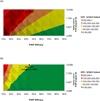The cost-effectiveness of preexposure prophylaxis for HIV prevention in the United States in men who have sex with men
- PMID: 22508731
- PMCID: PMC3690921
- DOI: 10.7326/0003-4819-156-8-201204170-00001
The cost-effectiveness of preexposure prophylaxis for HIV prevention in the United States in men who have sex with men
Abstract
Background: A recent randomized, controlled trial showed that daily oral preexposure chemoprophylaxis (PrEP) was effective for HIV prevention in men who have sex with men (MSM). The Centers for Disease Control and Prevention recently provided interim guidance for PrEP in MSM at high risk for HIV. Previous studies did not reach a consistent estimate of its cost-effectiveness.
Objective: To estimate the effectiveness and cost-effectiveness of PrEP in MSM in the United States.
Design: Dynamic model of HIV transmission and progression combined with a detailed economic analysis.
Data sources: Published literature.
Target population: MSM aged 13 to 64 years in the United States.
Time horizon: Lifetime.
Perspective: Societal.
Intervention: PrEP was evaluated in both the general MSM population and in high-risk MSM and was assumed to reduce infection risk by 44% on the basis of clinical trial results.
Outcome measures: New HIV infections, discounted quality-adjusted life-years (QALYs) and costs, and incremental cost-effectiveness ratios.
Results of base-case analysis: Initiating PrEP in 20% of MSM in the United States would reduce new HIV infections by an estimated 13% and result in a gain of 550,166 QALYs over 20 years at a cost of $172,091 per QALY gained. Initiating PrEP in a larger proportion of MSM would prevent more infections but at an increasing cost per QALY gained (up to $216,480 if all MSM receive PrEP). Preexposure chemoprophylaxis in only high-risk MSM can improve cost-effectiveness. For MSM with an average of 5 partners per year, PrEP costs approximately $50,000 per QALY gained. Providing PrEP to all high-risk MSM for 20 years would cost $75 billion more in health care-related costs than the status quo and $600,000 per HIV infection prevented, compared with incremental costs of $95 billion and $2 million per infection prevented for 20% coverage of all MSM.
Results of sensitivity analysis: PrEP in the general MSM population would cost less than $100,000 per QALY gained if the daily cost of antiretroviral drugs for PrEP was less than $15 or if PrEP efficacy was greater than 75%.
Limitation: When examining PrEP in high-risk MSM, the investigators did not model a mix of low- and high-risk MSM because of lack of data on mixing patterns.
Conclusion: PrEP in the general MSM population could prevent a substantial number of HIV infections, but it is expensive. Use in high-risk MSM compares favorably with other interventions that are considered cost-effective but could result in annual PrEP expenditures of more than $4 billion.
Primary funding source: National Institute on Drug Abuse, Department of Veterans Affairs, and National Institute of Allergy and Infectious Diseases.
Figures


Similar articles
-
Cost-effectiveness analysis of pre-exposure prophylaxis for the prevention of HIV in men who have sex with men in South Korea: a mathematical modelling study.Sci Rep. 2020 Sep 3;10(1):14609. doi: 10.1038/s41598-020-71565-y. Sci Rep. 2020. PMID: 32884082 Free PMC article.
-
The cost-effectiveness and population outcomes of expanded HIV screening and antiretroviral treatment in the United States.Ann Intern Med. 2010 Dec 21;153(12):778-89. doi: 10.7326/0003-4819-153-12-201012210-00004. Ann Intern Med. 2010. PMID: 21173412 Free PMC article.
-
Implementation and Operational Research: A Cost-Effective, Clinically Actionable Strategy for Targeting HIV Preexposure Prophylaxis to High-Risk Men Who Have Sex With Men.J Acquir Immune Defic Syndr. 2016 Jul 1;72(3):e61-7. doi: 10.1097/QAI.0000000000000987. J Acquir Immune Defic Syndr. 2016. PMID: 26977749
-
Cost-effectiveness of screening high-risk HIV-positive men who have sex with men (MSM) and HIV-positive women for anal cancer.Health Technol Assess. 2010 Nov;14(53):iii-iv, ix-x, 1-101. doi: 10.3310/hta14530. Health Technol Assess. 2010. PMID: 21083999 Review.
-
What do we know about the cost-effectiveness of HIV preexposure prophylaxis, and is it affordable?Curr Opin HIV AIDS. 2016 Jan;11(1):56-66. doi: 10.1097/COH.0000000000000217. Curr Opin HIV AIDS. 2016. PMID: 26569182 Review.
Cited by
-
Cost-Effectiveness of HIV Preexposure Prophylaxis for People Who Inject Drugs in the United States.Ann Intern Med. 2016 Jul 5;165(1):10-19. doi: 10.7326/M15-2634. Epub 2016 Apr 26. Ann Intern Med. 2016. PMID: 27110953 Free PMC article.
-
Sensitivity of joint contagiousness and susceptibility-based dynamic optimal control strategies for HIV prevention.PLoS One. 2018 Oct 18;13(10):e0204741. doi: 10.1371/journal.pone.0204741. eCollection 2018. PLoS One. 2018. PMID: 30335855 Free PMC article.
-
Development and Calibration of a Dynamic HIV Transmission Model for 6 US Cities.Med Decis Making. 2020 Jan;40(1):3-16. doi: 10.1177/0272989X19889356. Epub 2019 Dec 22. Med Decis Making. 2020. PMID: 31865849 Free PMC article.
-
The Relative Impact of Community and Hospital Antibiotic Use on the Selection of Extended-spectrum Beta-lactamase-producing Escherichia coli.Clin Infect Dis. 2019 Jun 18;69(1):182-188. doi: 10.1093/cid/ciy978. Clin Infect Dis. 2019. PMID: 30462185 Free PMC article.
-
Structural Barriers to Pre-exposure Prophylaxis Use Among Young Sexual Minority Men: The P18 Cohort Study.Curr HIV Res. 2018;16(3):237-249. doi: 10.2174/1570162X16666180730144455. Curr HIV Res. 2018. PMID: 30062970 Free PMC article.
References
-
- Centers for Disease Control and Prevention (CDC) Estimates of New HIV Infections in the United States. 2008 Accessed at http://www.cdc.gov/hiv/topics/surveillance/resources/factsheets/incidenc... on 30 September 2009.
-
- Centers for Disease Control and Prevention (CDC) Interim guidance: preexposure prophylaxis for the prevention of HIV infection in men who have sex with men. MMWR Morb Mortal Wkly Rep. 2011;60:65–68. - PubMed
Publication types
MeSH terms
Substances
Grants and funding
LinkOut - more resources
Full Text Sources
Medical
Research Materials
Miscellaneous
